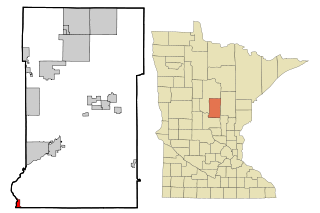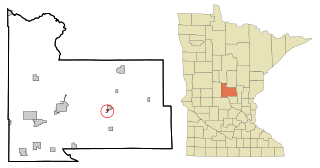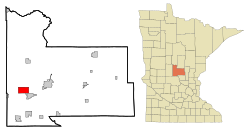
Morrison County is a county in the U.S. state of Minnesota. As of the 2020 census, the population was 34,010. Its county seat is Little Falls. Camp Ripley Military Reservation occupies a significant area in north-central Morrison County.
Ball Bluff Township is a township in Aitkin County, Minnesota, United States. The population was 270 as of the 2020 census. The 2021 population estimate is 274.
Spalding Township is a township in Aitkin County, Minnesota, United States. The population was 329 as of the 2010 census.
Shafer Township is a township in Chisago County, Minnesota, United States. The population was 1,048 as of the 2010 census, up from 646 in 2000.

Fort Ripley is a city in Crow Wing County, Minnesota, United States, near the confluence of the Mississippi and Nokasippi Rivers. The population was 69 at the 2010 census. It is part of the Brainerd Micropolitan Statistical Area.
Culdrum Township is a township in Morrison County, Minnesota, United States. The population was 505 at the 2000 census.

Elmdale is a city in Morrison County, Minnesota, United States. The population was 114 at the 2020 census.

Harding is a city in Morrison County, Minnesota, United States. The population was 123 at the 2020 census.

Hillman is a city in Morrison County, Minnesota, United States. The population was 23 at the 2020 census.

Randall is a city in Morrison County, Minnesota, United States. The population was 607 at the 2020 census.

Sobieski is a city in Morrison County, Minnesota, United States. The population was 210 at the 2020 census.

Swanville is a city in Morrison County, Minnesota, United States. A very small portion of the city extends into Todd County. The population was 326 at the 2020 census.

Two Rivers Township is a township in Morrison County, Minnesota, United States. The population was 780 at the 2020 census.

Upsala is a city in Morrison County, Minnesota, United States. The population was 487 at the 2020 census, up from 427 in 2010.

Chippewa Falls Township is a township in Pope County, Minnesota, United States. The population was 231 at the 2000 census. It includes the unincorporated community of Terrace, Minnesota.

Delhi Township is one of the twenty-six townships of Redwood County, Minnesota, United States. The population was 298 at the 2000 census.

Redwood Falls Township is one of the twenty-six townships of Redwood County, Minnesota, United States. The population was 256 at the 2000 census.
Little Elk Township is a township in Todd County, Minnesota, United States. The population was 340 at the 2000 census and was 266 at the time of the 2020 Census.

Genola is a city in Morrison County, Minnesota, United States. The population was 70 at the 2020 census.

Motley is a city in Morrison and Cass counties in the U.S. state of Minnesota. The population was 680 at the 2020 census. The main part of Motley is located within Morrison County; only a minor part of the city extends into Cass County.
















